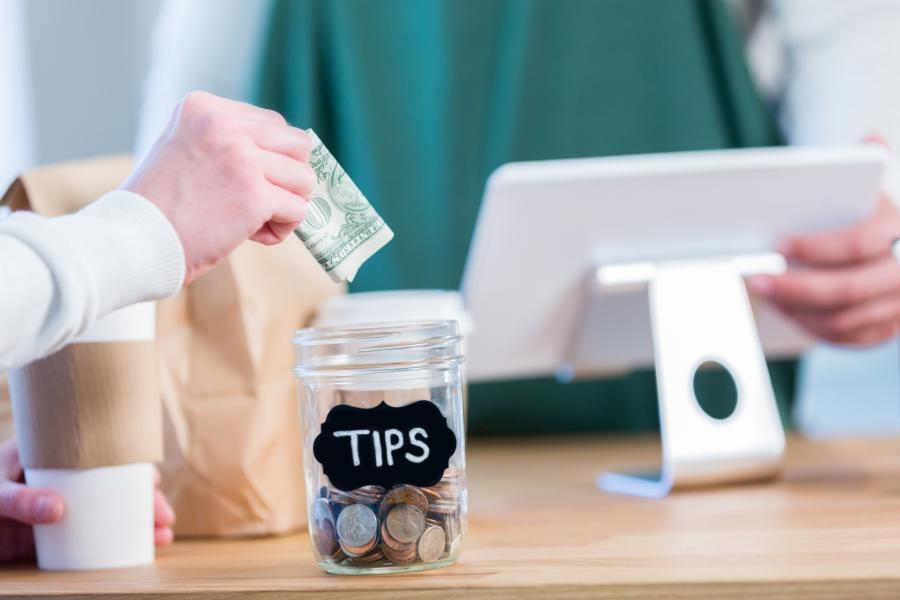It's being asked more and more: "Add a tip?" The question pops up on checkout screens when we're just grabbing a coffee to go or picking up a lunch order. Starbucks, for instance, added the tip query to its sales system last year. The countertop tip jar full of crumpled singles and loose change seems to have gotten an upgrade. The tip prompt has even been spotted at self-checkout kiosks in places such as airports and stadiums.
We're used to tipping at restaurants, where it's understood (in the United States, anyway) that servers are paid a near-negligible hourly wage and rely on tips. And, of course, their labors are visible and contribute to a successful dining experience. But now we are increasingly prompted to tip after transactions where the service was minimal and there was little or no human interaction.
We asked Shubhranshu Singh, an associate professor of marketing at the Johns Hopkins Carey Business School, what's going on. Is this just the tip of the iceberg when it comes to proliferation of tips? Or have consumers reached a tipping point and a backlash is brewing? The short answer: It's complicated.
What's with all the new tip prompts?
In some cases, it is just the new point-of-sale interface being used. That software has the option to add a tip and businesses are just using it. But I feel the consumer understands where they are expected to tip and in what places they are not expected to tip, right? Maybe the first time they see a new tip prompt, they think, OK, this is an unfamiliar situation. Remember the first time you were asked if you would donate $1 for some charity when you were checking out at the grocery store or somewhere? Because it was in a public setting it felt like there was a lot of pressure. This is similar. There's this screen that gets turned around and everybody is looking at that screen. For the first few times you may say yes, but I think over time people are going to realize that, no, this is not fair. I'm not going to tip.
And another thing that retailers and restaurants have done is choose the tip percentage defaults. And we know that consumers don't like to change from defaults for a variety of reasons. If they're in a rush and have the option to choose to tip 22%, 25%, 28%, they just pick 22% because that's the lowest they see there. Later, they realize they paid too much tip. They usually tip no more than 15% and they feel like they got tricked. Consumers will learn that there is an option to enter a custom tip. I feel that more and more consumers are going to click at that custom tip option.
So it's the employer not the employees driving this?
What is happening is that their costs have gone up. Inflation has hit. There is strong retail competition and some businesses have not fully recovered after COVID. They are facing pressure to not increase prices, while at the same they are having to pay more to hire people. That's why they're kind of looking for ways to get more money to support the business.
Is part of this phenomenon trading on the buildup of goodwill toward essential and frontline workers that occurred during the lockdowns?
There is that element for sure. One force driving this is how we treat people and whether we are willing to compensate them. But at the same time, everybody is feeling the pressure from inflation. Prices have gone up and incomes have not gone up as much, and there is this pressure to spend less.
For those consumers who have already reached a tipping point and want to be rid of all these tip prompts, it could be a case of be careful what you wish for in this economy.
I think so. Prices are going to go up one way or another. The consumer is going to pay, either in their prices or their tips.
It sounds like it's too soon to call this tipping landscape the new normal.
I don't think it's a new normal—yet. We may go back to lower tips if consumers really feel that's the way to go and react strongly. They could change their default places to shop. Suppose we see that some businesses decide against such tipping? They are going to choose to make consumers more comfortable by not requiring this kind of tipping. That can be a strategy to attract customers. It's an evolving situation. And what happens eventually, I think, is going to be decided by how the market reacts.
Posted in Voices+Opinion, Politics+Society
Tagged consumer behavior








